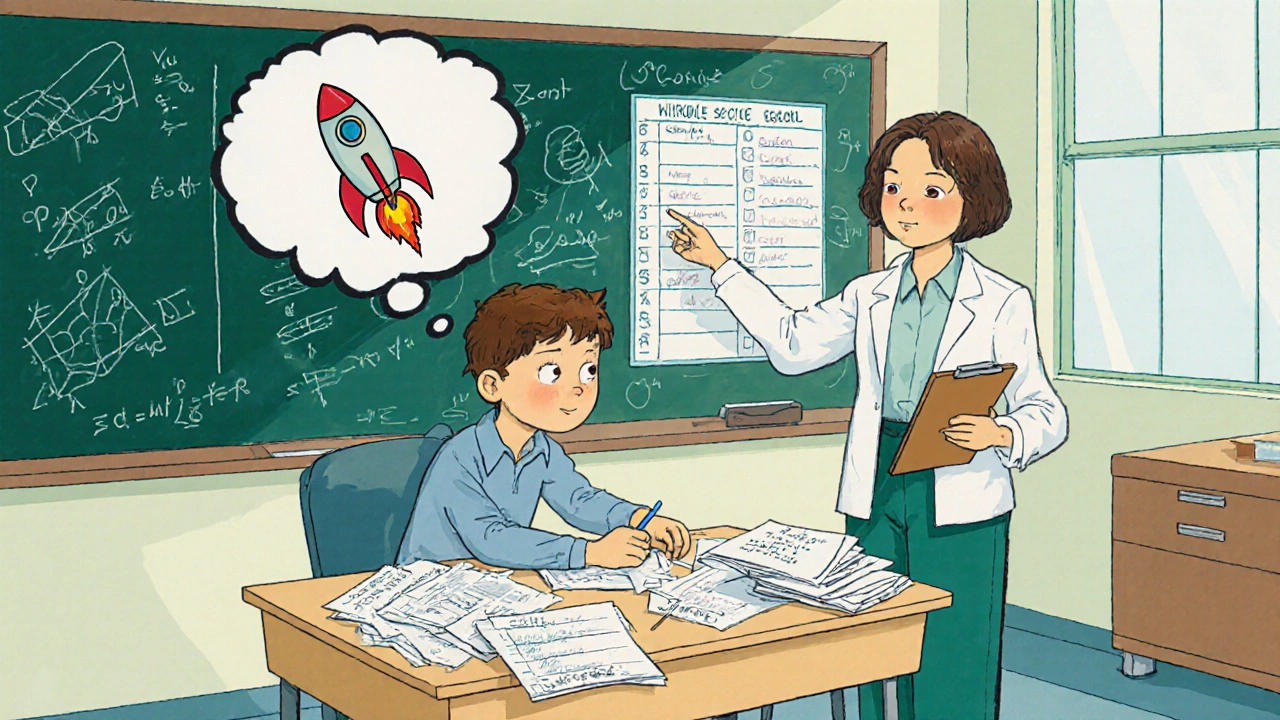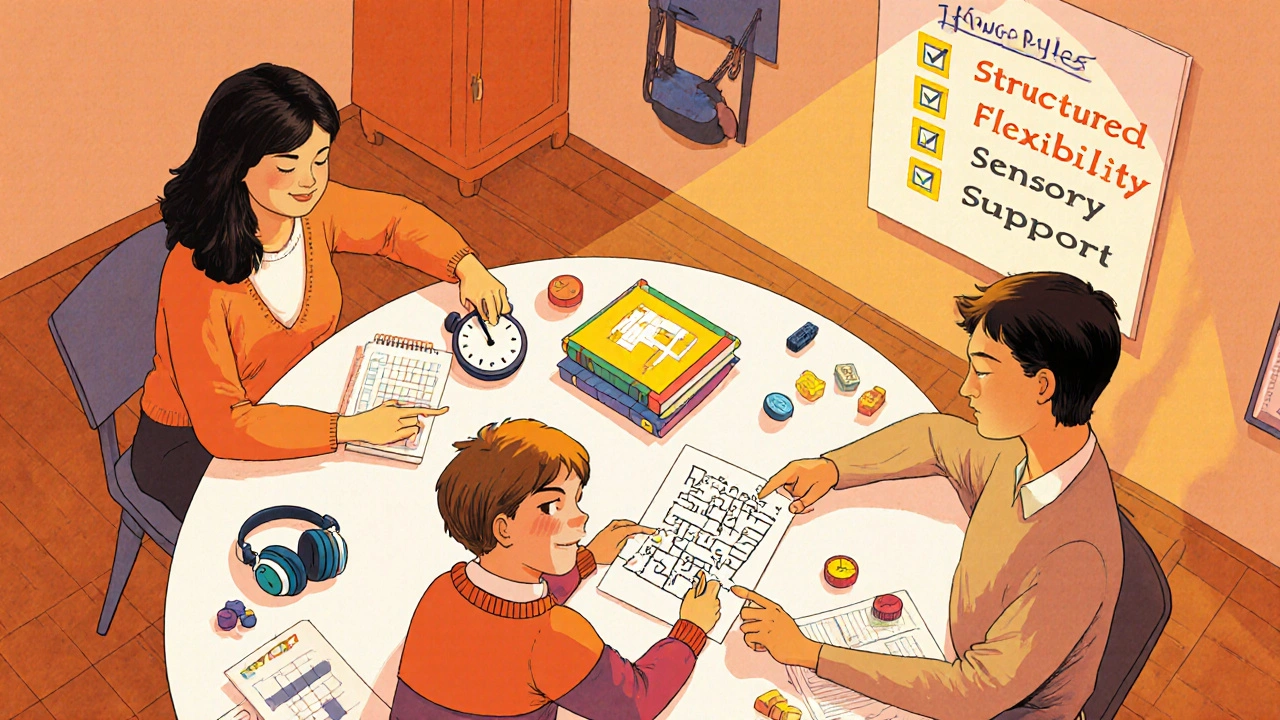Twice Exceptional (2e) Screening Tool
This tool helps identify potential signs of twice-exceptional (2e) learners who exhibit both ADHD traits and giftedness. It is not a diagnostic tool but can help determine if professional evaluation is needed. Answer the questions below to see if your child might benefit from a comprehensive assessment.
Imagine a child who can solve a Sudoku puzzle in seconds but can’t sit still long enough to finish a math worksheet. That clash often points to a hidden link between ADHD and giftedness. Parents, teachers, and clinicians frequently wonder why high‑ability learners sometimes look undisciplined or why an energetic kid may also be unusually bright. This article unpacks the science, the myths, and the day‑to‑day tactics that help families support kids who live at the intersection of two very different neuro‑profiles.
What is ADHD?
ADHD is a neurodevelopmental disorder characterized by persistent patterns of inattention, hyperactivity, and impulsivity that interfere with functioning or development. According to the WHO, about 5‑7% of children worldwide meet diagnostic criteria. Core symptoms include difficulty sustaining focus, acting without thinking, and a constant need for movement. These traits can lead to academic struggles, social friction, and low self‑esteem when they’re not recognized early.
What is Giftedness?
Giftedness refers to an individual's exceptional intellectual, creative, artistic, or leadership abilities that are markedly above age‑level expectations. In educational settings, giftedness is often measured by an Intelligence Quotient (IQ) of 130 or higher, rapid learning speed, and advanced problem‑solving skills. While gifted children can excel with minimal effort, they also experience unique emotional and social pressures, such as perfectionism and heightened sensitivity.
Overlap: When ADHD Meets Giftedness
When a child shows both ADHD traits and exceptional ability, they are labelled Twice Exceptional (or “2e”). These students may appear “lazy” in school because the curriculum doesn’t challenge them, prompting heightened restlessness. Conversely, their rapid thinking can amplify distractibility, leading teachers to misinterpret their behavior as disengagement.
The overlap is not coincidence; neuro‑biological research suggests shared pathways involving dopamine regulation, executive function, and sensory processing. Executive Function -the brain’s ability to plan, organize, and regulate emotions-is often uneven in 2e learners, with strong logical reasoning but weak self‑monitoring.
How the Two Profiles Interact
Key interaction points include:
- Masking: Gifted children may hide ADHD symptoms by relying on intellectual strengths, delaying diagnosis.
- Accelerated Learning vs. Distraction: Rapid acquisition of new concepts can be interrupted by impulsive shifts in attention.
- Sensory Overload: Sensory Processing issues common in ADHD can overwhelm a gifted child’s heightened emotional landscape.

Quick Comparison Table
| Trait | ADHD | Giftedness | Twice Exceptional |
|---|---|---|---|
| Attention Span | Short, easily diverted | Deep focus on interest areas | Variable - hyperfocus on strengths, drift on routine tasks |
| Learning Speed | Average to below average without support | Fast, often skips steps | Fast in strengths, slow in executive tasks |
| Emotional Reactivity | Impulsive, quick frustration | Heightened sensitivity, perfectionism | Combination leads to intense stress |
| Social Interaction | May be intrusive or withdrawn | Often older peers, may feel isolated | Struggles fitting in, risk of peer rejection |
| Executive Function | Weak planning, organization | Strong analytical reasoning | Uneven - bright ideas but poor follow‑through |
Diagnosis Challenges
Identifying a 2e child is tricky because standard assessments often target only one dimension. A gifted child may score high on IQ tests, masking inattentiveness, while a child with ADHD may underperform on achievement tests, hiding intellectual potential.
Key pitfalls include:
- Label Overlap: Schools might label the student merely “behavioral” without a formal ADHD assessment.
- Insufficient Testing: Relying on a single IQ test ignores the nuanced profile of executive function deficits.
- Cultural Bias: Expectations around “quiet brilliance” can vary, leading to missed diagnoses in diverse communities.
Best practice calls for a multi‑disciplinary evaluation: a School Psychologist, a pediatric neuropsychologist, and input from parents and teachers.
Practical Strategies for Parents and Educators
Whether you’re at home or in a classroom, the goal is to harness the child’s strengths while scaffolding weak areas.
- Structured Flexibility: Provide clear routines but allow movement breaks during intense focus periods.
- Tiered Assignments: Offer enrichment tasks for gifted parts and step‑by‑step scaffolds for executive challenges.
- Executive Function Coaching: Use visual planners, timers, and checklists to externalize memory.
- Sensory Supports: Noise‑cancelling headphones or fidget tools can reduce overload.
- Positive Behavior Interventions: Reinforce effort rather than outcome; use specific praise like “You stayed on task for 15 minutes.”
- Collaborative Goal‑Setting: Involve the child in setting realistic academic and personal goals.

Common Myths Debunked
- Myth: Gifted kids don’t need special education.
Fact: Many are twice exceptional and benefit from tailored support. - Myth: ADHD is just “bad behavior.”
Fact: It’s a brain‑based condition with measurable neurochemical differences. - Myth: High IQ protects against ADHD.
Fact: Intelligence can mask symptoms but does not eliminate them.
Quick Checklist for Early Identification
- Shows intense focus on topics of interest, but drifts on routine tasks.
- Completes complex problems quickly yet struggles with organization.
- Expresses frustration when challenged by uninteresting work.
- Displays sensory sensitivities (noise, textures) that affect mood.
- Receives mixed feedback: “bright” from teachers, “disruptive” from others.
Next Steps and Resources
If you suspect a child is twice exceptional, consider these actions:
- Request a comprehensive evaluation from a qualified pediatric neuropsychologist.
- Gather classroom observations, work samples, and standardized test results.
- Connect with local support groups-often hosted by universities or gifted societies.
- Explore evidence‑based interventions: cognitive‑behavioral therapy, executive function coaching, and differentiated curricula.
- Maintain open communication between home and school to adjust accommodations as the child’s needs evolve.
Frequently Asked Questions
Can a child be both ADHD and gifted?
Yes. When a child meets criteria for ADHD and also demonstrates high intellectual ability, they are considered twice exceptional. This dual profile is common and requires specialized assessment.
How does ADHD affect a gifted child’s learning?
ADHD can interrupt a gifted child’s deep focus, leading to unfinished projects, missed deadlines, and frustration. The child may also become bored with standard curriculum, increasing restlessness.
What assessment tools are best for identifying twice exceptional learners?
A combination of cognitive ability tests (e.g., WISC‑V), achievement measures, behavior rating scales (e.g., Conners‑3), and executive‑function assessments provides a holistic view. Input from parents, teachers, and a school psychologist is essential.
Are there medication concerns for gifted children with ADHD?
Medication can improve attention and reduce impulsivity, but dosage may need careful tuning to avoid blunting creativity. Regular monitoring by a pediatrician familiar with giftedness is recommended.
What classroom accommodations help 2e students thrive?
Strategies include flexible seating, extended time on tests, enrichment projects, visual schedules, and explicit executive‑function coaching. Collaboration between teachers and specialists ensures the plan fits both strengths and challenges.


eric smith
October 21, 2025 AT 01:02Oh great, another buzzword label for kids who just happen to think faster than their teachers can keep up. While the article tries to sound scientific, it glosses over the fact that most of these so‑called “twice‑exceptional” kids are just regular kids with too much caffeine and not enough structure. The dopamine talk is cute, but you can’t cure a restless mind with a fancy acronym. If you want real help, stop romanticizing the struggle and give them a schedule that actually works, not just a checklist of myths to debunk.
Devendra Tripathi
October 21, 2025 AT 04:00Look, the whole premise that ADHD and giftedness are somehow magically linked is a narrative sold to schools to excuse under‑funded programs. The data is cherry‑picked, and the neuro‑biology you cite is nothing more than speculative jargon. Real educators know that you can’t blame a child’s poor performance on “over‑active dopamine”; you need concrete interventions, not vague talk about executive function. Stop feeding the myth and start demanding evidence‑based curricula that challenge all students, gifted or not.
Nick M
October 21, 2025 AT 07:36Here we have another instance of the elite‑education lobby pushing a conspiracy of “special needs” to siphon resources away from the average classroom. The article’s “research” is nothing but recycled boilerplate from think‑tanks funded by pharmaceutical giants. If you’re looking for a real explanation, consider the hidden agenda: keep the market for stimulant meds alive while pretending it’s about nurturing brilliance.
Ericka Suarez
October 21, 2025 AT 10:40Congrats on re‑inventing the wheel, but let’s get real – you’re just spoutin’ off the same old American‑centric hype. My kids don’t need “fidget tools” or “noise‑cancelling headphones”; they need a school that stops pandering to every self‑identified label and actually teaches basics. Also, your list of accommodations reads like a grocery list from a discount store – cheap and unoriginal.
Casey Cloud
October 21, 2025 AT 14:00From a practical standpoint, the most effective strategy is breaking tasks into micro‑steps and pairing them with visual timers. Kids with ADHD often thrive when they can see time passing, and gifted children appreciate the clarity of a concrete roadmap. Combine that with a flexible seating arrangement – let them stand or use a wobble stool – and you’ll notice a drop in off‑task behavior. Also, regular brief check‑ins with a coach can help them internalize planning skills without feeling micromanaged.
Rachel Valderrama
October 21, 2025 AT 17:03Alright, let’s pump some energy into that advice – think of it as a “brain‑boost” hack! Give the kid a 5‑minute movement break after every 20‑minute focus sprint, and watch the hyperfocus switch to productive output. Celebrate tiny wins with loud, enthusiastic praise – “You crushed that problem set!” – because motivation fuels both the ADHD drive and the gifted curiosity. Keep it fun, keep it fast, and the results will speak for themselves.
Brandy Eichberger
October 21, 2025 AT 18:43It’s truly refreshing to see an article that treats twice‑exceptional learners with the nuance they deserve. By acknowledging both the strengths and the challenges, we can craft educational experiences that honor intelligence without ignoring the need for structure. I’d love to see more schools adopt differentiated curricula that seamlessly integrate enrichment with executive‑function scaffolding.
Eli Soler Caralt
October 21, 2025 AT 22:20🌟 When we contemplate the convergence of hyper‑cognitive velocity and neuro‑chemical turbulence, we glimpse a micro‑cosm of the broader human condition. The gifted mind, like a comet, arcs across the firmament of knowledge, leaving trails of insight that inspire collective advancement. Yet, the ADHD component injects stochastic variability, a sort of beautiful chaos that prevents the comet from stagnating into predictability. This dialectic underpins the notion of "twice‑exceptional" as not merely a diagnostic category, but a philosophical archetype of potential unbounded by linear constraints.
In practical terms, educators should cultivate environments where divergent thinking is celebrated while providing modular frameworks that channel frenetic energy into purposeful inquiry. Structured flexibility, as the article suggests, serves as the scaffolding that transforms erratic motion into directed exploration.
Consider, for instance, a classroom matrix where autonomous project slots coexist with timed micro‑tasks, granting the student agency to oscillate between deep focus and kinetic release. Such an ecosystem mirrors the brain’s own oscillatory rhythms, aligning pedagogy with neurobiology.
Moreover, sensory modulation-through acoustic dampening, tactile fidgets, or kinetic seating-operates not as a remedial crutch but as an enhancer of the gifted child’s capacity to sustain concentration on complex abstractions. The neuro‑chemical dance of dopamine and norepinephrine thus becomes a lever, not a liability.
In sum, the 2e profile invites us to re‑imagine education as a dynamic, non‑linear process, one that honors both the meteoric ascent of intellect and the grounding force of executive regulation. 🌈
Eryn Wells
October 21, 2025 AT 22:53🌍 Embracing neurodiversity makes classrooms richer for everyone.
Kathrynne Krause
October 22, 2025 AT 00:16Let’s celebrate the kaleidoscope of minds that light up our schools! When a child’s brain fires like fireworks, we should channel that brilliance with vibrant, hands‑on projects and quick‑fire challenges. Pair that with gentle reminders to pause, breathe, and organize – think colorful charts and playful timers. By weaving creativity and structure together, we empower every learner to shine without burning out.
Vivian Annastasia
October 22, 2025 AT 01:23Sure, let’s all jump on the “celebrate every quirky brain” bandwagon while ignoring the fact that many of these so‑called strategies are just repackaged buzzwords. If you’re not going to mention the downsides of over‑medicating or the reality that some schools will just slap a label on kids for funding, then you’re only offering a half‑truth. The article could have been sharper about the systemic issues at play.
John Price
October 22, 2025 AT 02:13Interesting read, but the real test is how these ideas work in everyday classrooms.